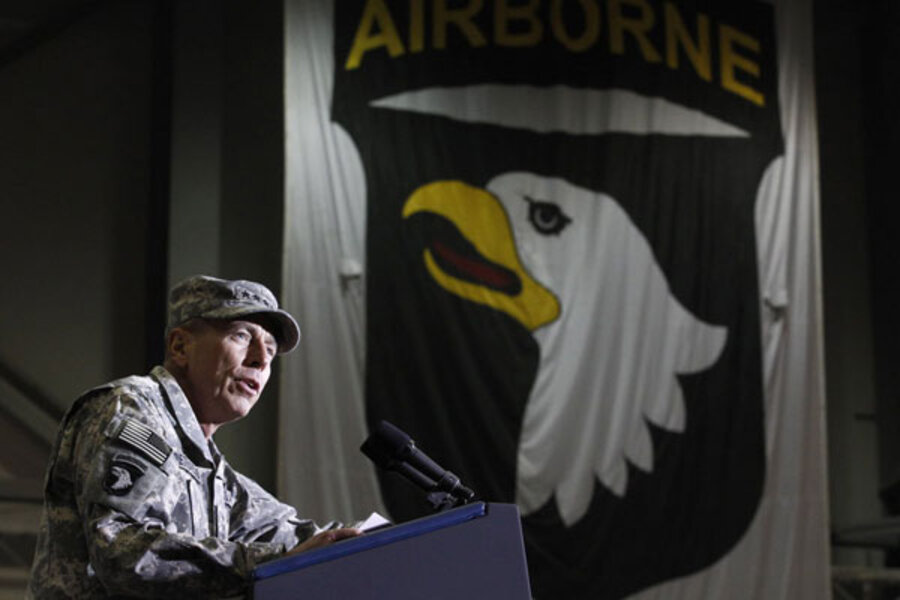How Petraeus has changed the Afghanistan war
Loading...
| Washington
When Gen. David Petraeus took over as head of US forces in Afghanistan earlier this year, there was some speculation about the extent to which he would run the war differently from his predecessor.
The general consensus was that there wouldn’t be much difference between Petraeus and Gen. Stanley McChrystal, who was forced to resign in June after he made impolitic comments about members of the Obama administration. Both were known as staunch adherents of counterinsurgency warfare, which tends to emphasize protecting the population over, say, body counts as a measure of success.
In many ways, this conventional wisdom has been borne out. But as the year draws to a close, there are, say senior US military officials, some clear differences emerging in the way Petraeus is now handling the Afghanistan war. Chief among the changes is one that represents something of a gamble to some in the Pentagon.
Specifically, Petraeus has chosen to emphasize the violence that the Taliban and other insurgent groups have inflicted on the general Afghan population. This may seem like an obvious approach. Why not highlight the harm that your enemy is doing to the civilians you’re trying to win over?
But it’s not so simple, says a senior military official, who spoke on condition of anonymity because he has not been authorized to speak to the press on this issue. “If you draw attention to the enemies’ impact on Afghan civilians, does that make them feel less secure” – and consequently, less willing to support NATO forces?
“That is the debate: Do they perceive a greater insecurity or do they perceive the enemy in a more negative way?” adds the official. “There are arguments on both sides.”
In most respects, Petraeus and McChrystal have run the war similarly. “You’re talking about vanilla versus French vanilla," says Andrew Krepinevich, Pentagon adviser and president of the Center for Strategic and Budgetary Analysis, a Washington think tank. "At the end of the day it takes a very sophisticated palate to discern the differences between the two.”
But McChyrstal chose not to emphasize Taliban violence against the population for fear of making Afghans wary of a war that was not going well, and of a NATO force that was failing to protect them, says the official. “With M-4” – the military’s nickname for four-star general McChrystal – “there was a lot of discussion among his staff on the impact on the population.”
The focus of the generals is a product of their experiences. “Both officers come from very different operational backgrounds,” says Andrew Exum, a former Army Ranger and fellow with the Center for a New American Security in Washington. “General Petraeus – his experience in the Army has been such that he spent a lot of time at a young age doing strategic assignments and thinking about the big implications of operations.”
While “General McChrystal brought operational art to a new level, General Petraeus is more experienced dealing with larger strategic issues,” he adds.
The decision to emphasize or de-emphasize Taliban violence has also hinged on the audience that the generals have wanted to reach. For Petraeus, that audience is international – he recognizes the importance of keeping the NATO coalition together in the face of home populations that are increasingly skeptical of the war, says the official.
“The thinking is that if he can draw more attention to Taliban atrocities, it will garner more support for among European partners who are sympathetic to human rights appeals," the official says.
But this comes with risks as well. “What Petraeus is emphasizing a bit more than McChrystal is winning hearts: Can you convince the population that you’re the side that should remain victorious?” says Mr. Krepinevich. “Part of doing this is also to show people that the Taliban don’t respect human rights and human dignity.”
But winning minds is a key part of counterinsurgency warfare too, Krepinevich adds. “That has to do with convincing the population that not only should they want you to win, but they have confidence that you will.”
The problem is that, “No matter how much he may want you to win, if he thinks your adversary is going to win he’s going to remain aloof, and he’s going to withhold his support.” And that, military officials add, is the challenge that Petraeus will continue to face in the months to come.





